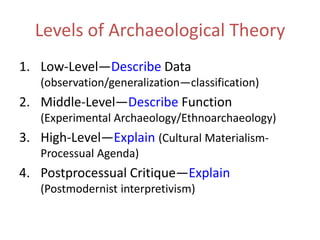
Levels of archaeological theory illustrated 2
- 1. Levels of Archaeological Theory Low-Level—Describe Data (observation/generalization—classification) Middle-Level—Describe Function (Experimental Archaeology/Ethnoarchaeology) High-Level—Explain(Cultural Materialism-Processual Agenda) Postprocessual Critique—Explain(Postmodernist interpretivism)
- 2. Ancient Hoko River Fishhooks Low-Level—Describe Data (observation/generalization—classification)
- 8. Ancient Hoko River Baskets Low-Level—Describe Data (observation/generalization—classification)
- 12. Basket attributes (Croes, 1977)
- 13. Basket shapes (Croes, 1977)
- 14. Sample basket type, (Lachane, BC, ~2000 BP)
- 15. Ancient Hoko River Fishhooks Low-Level—Describe Data (observation/generalization—classification)
- 32. Ancient Hoko River Fishhooks Middle-Level—Describe Function (Experimental Archaeology/Ethnoarchaeology)
- 51. Ancient Hoko River Fishhooks High-Level—Explain(Cultural Materialism-Processual Agenda)
- 52. One way (a materialist approach) to classify (separate) components of a culture Infrastructure Modes of Production and Reproduction Structure Domestic and Political Organization Superstructure Values and Beliefs Ideational Adaptive
- 53. Musqueam NE 3,000 BP Hoko River
- 56. Basketry attribute unrooted cladogram ~500 BP ~3,000 BP ~2,000 BP ~1,000 BP ~3,000 BP ~1,000 BP ~1,000 BP ~2,000 BP ~2,000 BP
- 57. Basketry Attributes Rooted Cladogram
- 58. Musqueam NE Water Hazard Conway Fishtown Hoko River Ozette A C Biederbost ~3000 BP ~2000 BP Qwu?gwes ~1000 BP
- 59. Phases based on stone bone and shell artifacts Coast Salish Wakashan Basketry/Ethnic Traditions
- 60. Slanted Cladogram Based on basketry attributes 3,000 years of cultural identity through specific basketry styles for Squaxin Island Tribe and all Coast Salish Peoples
- 62. A C B
- 64. One way (a materialist approach) to classify (separate) components of a culture Infrastructure Modes of Production and Reproduction Structure Domestic and Political Organization Superstructure Values and Beliefs Ideational Adaptive
- 65. Ancient Hoko River Fishhooks Postprocessual Critique—Explain(Postmodernist interpretivism)
- 72. Hoko River Vincent Cooke Excavating A 3000 yr old Cedar Bark Cape and Pack Basket
- 77. The Post-processual critique rejects: The cultural evolutionary generalizations The processual search for universal laws Explicitly scientific methods The processual emphasis on objectivity and ethical neutrality The processual view of culture as an extrasomatic means of adaptation The processual emphasis on etic phenomena
